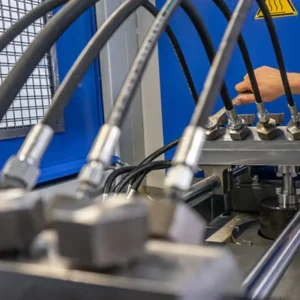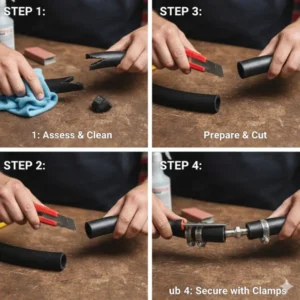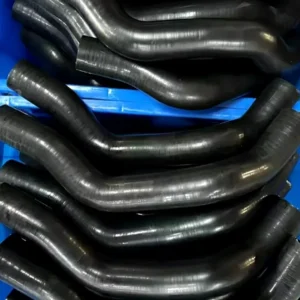The hydraulic hose chop saw is a specialized piece of equipment designed exclusively for cutting hydraulic hoses with extreme precision and minimal damage. Unlike a conventional metal chop saw, which uses an abrasive disc that can cause significant heat, fraying, and smoke, a hydraulic hose chop saw typically employs a fine-toothed blade, often carbide-tipped, operating at a specific speed.
This design ensures a clean, perpendicular cut that is crucial for maintaining the hose’s structural integrity and preventing contamination, preparing it perfectly for secure fitting crimping.
Key Characteristics of a Hydraulic Hose Chop Saw
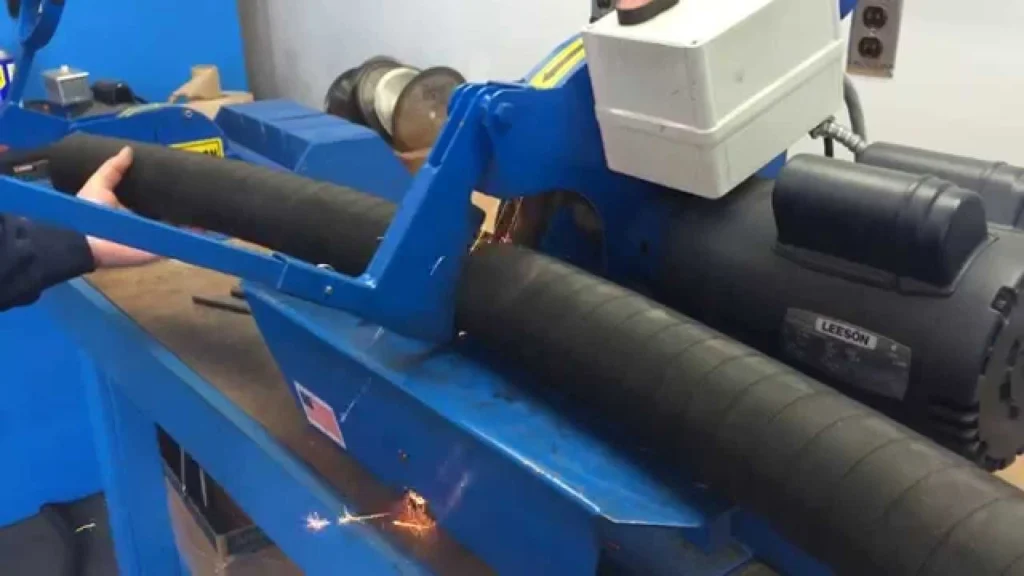
Specialized Blade Technology
The core of a hydraulic hose chop saw lies in its blade. These are typically thin, sharp, and often carbide-tipped, designed to shear through various hose materials, including rubber, thermoplastic, and steel wire reinforcement, without generating excessive heat or causing fraying. The unique tooth geometry and material composition of these blades allow for a smooth, precise cut that is vital for proper hose assembly.
Optimized Cutting Speed
Operating at a meticulously optimized speed, a hydraulic hose chop saw minimizes the risk of melting thermoplastic materials or causing heat-related damage to rubber components.
This controlled cutting action ensures that the hose material remains intact and free from distortion, which is critical for maintaining the internal cleanliness of the hose and the reliability of the eventual hose assembly.
Enhanced Safety Features
Safety is paramount when working with cutting tools. A hydraulic hose chop saw typically incorporates robust safety guards, emergency stop buttons, and dust collection ports. These features protect the operator from flying debris, minimize exposure to hazardous particles, and ensure a safer working environment during the hose cutting process, emphasizing operator well-being and compliance with safety standards.
Stable Clamping Mechanism
To achieve the precise, perpendicular cuts required for hydraulic hoses, a hydraulic hose chop saw is equipped with a stable and secure clamping mechanism. This vise-like system firmly holds the hose in place during the cutting operation, preventing movement, vibration, and distortion.
A consistent and secure clamp ensures that each cut is perfectly straight, contributing significantly to the quality of the finished hose assembly.
How Does a Hydraulic Hose Chop Saw Work?
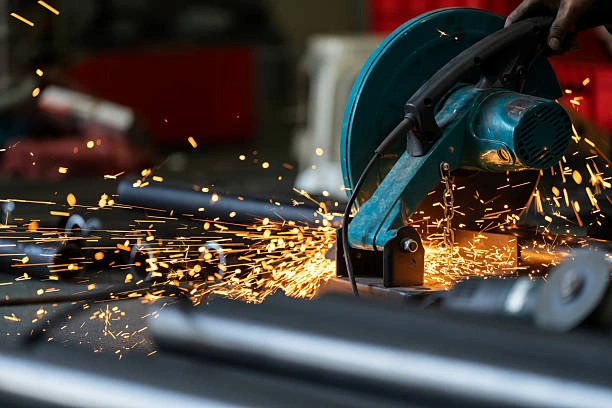
Understanding the operational principles of a hydraulic hose chop saw is key to appreciating its efficiency and precision. It combines mechanical power with specialized blade technology to deliver clean cuts. The process involves securing the hose, activating the motor, and carefully lowering the blade through the hose material. This method ensures that the internal components of the hose remain undisturbed, providing an ideal surface for subsequent crimping.
Securing the Hose
The first critical step in operating a hydraulic hose chop saw involves securely clamping the hydraulic hose. The chop saw’s integrated vise system features jaws designed to firmly grip the hose, preventing any movement or rotation during the cutting process. Proper clamping ensures that the cut is perfectly perpendicular to the hose axis, which is essential for a leak-free connection when fittings are crimped onto the hose end.
Activating the Blade
Once the hose is securely clamped, the operator activates the hydraulic hose chop saw using a power switch or foot pedal. This engages the electric motor, which in turn spins the specialized cutting blade at its optimized speed. The blade rapidly reaches its operational velocity, prepared to slice through the hose material with minimal friction and heat generation, ensuring a clean and efficient cut.
Controlled Cutting Action
With the blade spinning, the operator carefully and steadily lowers the cutting head, bringing the blade into contact with the clamped hydraulic hose. The specialized teeth of the blade shear through the layers of rubber, textile, and wire reinforcement without excessive tearing or fraying. This controlled cutting action minimizes distortion and heat buildup, leaving a clean, smooth edge that is crucial for fitting crimping.
Waste and Debris Management
During the cutting process, a hydraulic hose chop saw often generates small amounts of material debris. Many modern chop saws are equipped with a dust collection port or an integrated waste containment system. This feature helps to capture particles and wire fragments, maintaining a cleaner workspace and reducing the risk of airborne contaminants. Proper waste management is essential for safety and efficiency.
How to Cut Hydraulic Hoses with Chop Saw
Cutting hydraulic hoses precisely with a hydraulic hose chop saw is a skill that combines proper technique with adherence to safety protocols. It involves accurate measurement, secure clamping, and a controlled cutting motion. Following these steps ensures not only a perfect cut but also the longevity and reliability of your hydraulic assemblies. Precision at this stage is non-negotiable for optimal performance.
- Measure and Mark:
- Action: Accurately measure the desired length of the hydraulic hose. Use a permanent marker to clearly mark the cutting point on the hose. Ensure measurements are precise, accounting for fitting insertion depth if necessary.
- Why it’s important: Incorrect length can lead to system inefficiencies, excess material usage, or even hose failure due to improper routing. A clear mark guides the cut.
- Secure the Hose in the Chop Saw:
- Action: Open the chop saw’s vise or clamping mechanism. Insert the hydraulic hose, aligning the marked cutting point precisely with the blade’s path. Tighten the vise firmly to ensure the hose is completely secure and cannot rotate or move during the cut.
- Why it’s important: A loose hose will result in an inaccurate, non-perpendicular, or jagged cut, making proper fitting crimping impossible and potentially leading to leaks.
- Wear Personal Protective Equipment (PPE):
- Action: Before operating the saw, don safety glasses or a face shield, sturdy work gloves, and hearing protection. Consider a dust mask if significant debris is expected.
- Why it’s important: Cutting hydraulic hoses can produce flying debris (rubber, wire strands), noise, and dust. PPE is essential to protect your eyes, hands, and hearing from potential injury.
- Initiate the Cut:
- Action: Power on the hydraulic hose chop saw. Allow the blade to reach its full operating speed before engaging with the hose. With a steady, controlled motion, slowly lower the blade through the hose. Avoid forcing the blade; let the saw do the work.
- Why it’s important: Allowing the blade to reach full speed ensures a cleaner cut and reduces strain on the motor. Forcing the cut can lead to blade damage, hose distortion, or unsafe operation.
- Clean the Cut End:
- Action: Once the cut is complete and the blade has stopped, carefully remove the hose from the clamp. Inspect the cut end for any remaining debris, stray wire strands, or rubber particles. Use a deburring tool, compressed air, or a specialized cleaning brush to remove any residue from both the exterior and interior of the hose.
- Why it’s important: Leaving debris or frayed material can contaminate the hydraulic system, causing damage to pumps, valves, and cylinders. A clean end is crucial for a proper seal during crimping.
Common Cutting Issues and Solutions
| Issue | Description | Possible Cause | Solution |
| Frayed or Uneven Cut | Hose end is messy, with loose rubber or wire strands. | Dull blade, incorrect blade type, forcing the cut, loose clamping. | Replace blade, ensure it’s a dedicated hose chop saw blade, use steady pressure, tighten clamp. |
| Burn Marks/Melting | Discoloration or melted thermoplastic around the cut. | Blade speed too high, incorrect blade material, insufficient cooling. | Verify correct blade type for hose material, reduce cutting speed if adjustable, ensure proper ventilation. |
| Non-Perpendicular Cut | Cut end is angled, not perfectly straight. | Hose not clamped securely, hose moved during cut, uneven pressure. | Re-clamp the hose firmly, ensure consistent downward pressure, check vise alignment. |
| Blade Wobble/Vibration | Blade vibrates excessively during operation. | Loose blade mounting, worn bearings, damaged blade. | Check blade mounting bolts, inspect bearings, replace damaged blade. |
| Excessive Smoke/Odor | Strong smell or visible smoke during cutting. | Sharpen or replace the blade, adjust cutting speed, ensure blade is appropriate for hose material. | Sharpen or replace the blade, adjust the cutting speed, and ensure the blade is appropriate for the hose material. |
Tips for Cutting Hydraulic Hoses
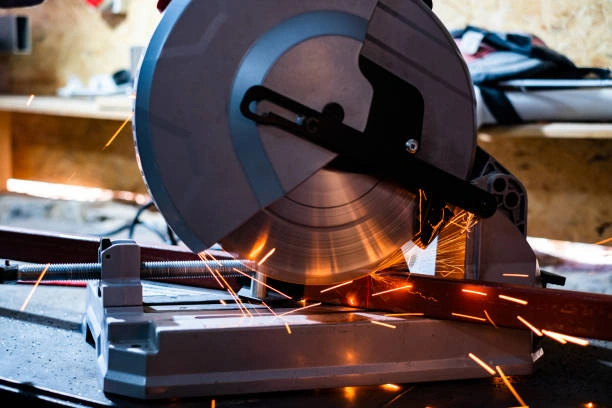
Achieving consistently high-quality cuts on hydraulic hoses with a hydraulic hose chop saw goes beyond basic operation. Incorporating a few key tips can significantly enhance precision, prolong blade life, and ensure the optimal preparation of your hose assemblies. These tips focus on blade maintenance, proper technique, and environmental considerations, all contributing to a more efficient and safer cutting process.
Choose the Right Blade for Your Hydraulic Hose Chop Saw
The blade is the heart of your hydraulic hose chop saw. Ensure you are using a sharp, fine-toothed blade specifically designed for hydraulic hose cutting. Carbide-tipped blades are often preferred for their durability and ability to cut through steel wire reinforcement cleanly. Using a dull or incorrect blade can lead to frayed cuts, excessive heat, and damage to the hose material. Regularly inspect your blade for wear and replace it as needed.
Maintain Consistent Downward Pressure
When cutting with a hydraulic hose chop saw, apply steady and consistent downward pressure. Avoid forcing the blade through the hose rapidly. Allowing the saw’s weight and the blade’s sharpness to do the work will result in a cleaner, more precise cut and prevent unnecessary strain on the motor and blade. Erratic pressure can lead to uneven cuts and premature blade wear.
Keep the Blade Clean
Residue from hose materials can accumulate on the blade of your hydraulic hose chop saw, affecting its cutting efficiency and causing friction. Periodically clean the blade according to manufacturer instructions. A clean blade will cut more smoothly, generate less heat, and provide a longer service life, ensuring consistent high-quality cuts for all your hydraulic hose assemblies.
Consider Cooling (If Applicable)
Some heavier-duty hydraulic hose chop saws or those cutting very tough hoses might benefit from cooling systems, although less common for typical R1/R2. If your saw is designed for it, or if you notice excessive heat buildup, ensure any integrated cooling mechanisms (like air jets) are functioning correctly. Reducing heat during the cut prevents material melting and distortion, especially with thermoplastic hoses, ensuring a clean finish.
Mark Accurately and Secure Firmly
Precise measurement and a secure clamp are fundamental. Before cutting with your hydraulic hose chop saw, measure your hose accurately and mark the cut line clearly. Then, ensure the hose is clamped extremely firmly in the saw’s vise. Any movement, slipping, or rotation of the hose during the cut will lead to an angled or uneven cut, compromising the integrity of your hydraulic hose assembly.
Discover The Variety Of Hydraulic Hose Chop Saw Solutions
The landscape of hydraulic hose chop saw technology offers a diverse range of solutions, each tailored to specific operational needs and volumes. From compact, portable units for field service to heavy-duty industrial machines designed for continuous production, understanding this variety is crucial for selecting the optimal equipment. This diversity ensures that, regardless of your scale of operation, there’s a specialized hydraulic hose chop saw available to deliver the precision and efficiency required for superior hose assembly.
Benchtop Hydraulic Hose Chop Saw for Small Workshops
For smaller workshops, mobile service vehicles, or occasional cutting needs, a benchtop hydraulic hose chop saw offers a compact and efficient solution. These units are typically lighter and more portable, making them easy to set up and move. Despite their size, they deliver precise cuts for various hose types, making them ideal for tasks where space is limited but professional-grade hose preparation is still required. Their user-friendly design ensures quick and accurate cuts.
Industrial Hydraulic Hose Chop Saw for High-Volume Production
In high-volume hose assembly facilities, an industrial hydraulic hose chop saw is a robust and essential investment. These heavy-duty machines are built for continuous operation, often featuring powerful motors, larger blades, and advanced safety systems. Designed for maximum throughput, they ensure consistent, precise cuts on a wide range of hose diameters and types, minimizing downtime and maximizing productivity in demanding production environments.
Portable Hydraulic Hose Chop Saw for Field Service
Field service technicians often require a portable hydraulic hose chop saw that can be easily transported to job sites. These lightweight and compact saws are designed for mobility, often operating on standard power outlets. They enable technicians to cut hydraulic hoses accurately on-site, reducing downtime for equipment and ensuring repairs can be made efficiently. Their rugged construction is built to withstand varied field conditions.
Hydraulic Hose Chop Saw with Integrated Fume Extraction
For enhanced safety and environmental compliance, a hydraulic hose chop saw with integrated fume extraction is crucial, especially when cutting rubber hoses that can produce smoke or fine particles. These saws feature built-in systems that capture airborne debris and fumes at the source, protecting the operator’s respiratory health and maintaining a cleaner workspace. This feature is particularly valued in enclosed environments.
Hydraulic Hose Chop Saw with Automatic Clamping
To streamline the cutting process and improve consistency, some advanced hydraulic hose chop saw models come with automatic clamping mechanisms. After placing the hose, the machine automatically secures it with consistent pressure, eliminating manual tightening. This feature reduces operator fatigue, speeds up the cutting cycle, and ensures a perfectly secure hold for every cut, leading to higher efficiency in high-volume operations.
Hydraulic Hose Chop Saw for Large Diameter Hoses
Cutting large diameter hydraulic hoses requires a specialized hydraulic hose chop saw designed for increased capacity and power. These saws feature larger blades, more robust motors, and wider clamping mechanisms to accommodate thicker and stiffer hoses. They ensure clean, precise cuts on challenging materials, preventing deformation and preparing large hoses effectively for high-pressure applications in heavy industries like mining or marine.
Hydraulic Hose Chop Saw with Digital Length Measurement
Precision is elevated with a hydraulic hose chop saw equipped with digital length measurement systems. These integrated digital readouts allow operators to set exact hose lengths electronically, ensuring highly accurate and repeatable cuts. This technology significantly reduces measurement errors, speeds up the cutting process, and is particularly beneficial for production lines requiring consistent hose lengths for complex assemblies.
Hydraulic Hose Chop Saw for Thermoplastic Hoses
While many chop saws can cut both, some hydraulic hose chop saws are optimized for thermoplastic hoses, like R7 or R8. These saws may feature specific blade types or speed settings to prevent melting or smearing of the thermoplastic material, ensuring a clean, burr-free cut. This specialization ensures the integrity of thermoplastic hoses, which are often used in sensitive or non-conductive applications.
Conclusion
The hydraulic hose chop saw is a specialized tool, pivotal for anyone involved in hydraulic system assembly or maintenance. Unlike standard saws, it’s engineered to deliver exceptionally clean, precise, and perpendicular cuts on hydraulic hoses, minimizing fraying and preventing contamination. This precision is vital for creating reliable, leak-free hose assemblies, ensuring fittings crimp securely and efficiently.

